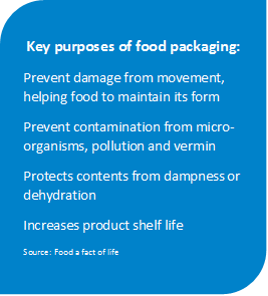Will a pledge against plastic change how food gets wrapped up?
Friday, 23 February 2018
Innovation in food packaging formats continues to expand functionality and improve the ability for consumers to engage with products. The Government announcement pledging to eliminate the use of avoidable plastic waste by 2042 is likely to have an impact on attitudes to the materials used and waste generated. So how might packaging change and what food products may benefit from innovation?
Why do we have packaging?
 Food packaging has many purposes: at a functional level it protects the product it contains, communicates information about the product and/or brand to the consumer and affects usability. It is essential to protect food from deteriorating while in storage and waiting to be sold. Developments have enabled food to be stored for longer before it is sold and at home before it is eaten, helping to reduce food waste.
Food packaging has many purposes: at a functional level it protects the product it contains, communicates information about the product and/or brand to the consumer and affects usability. It is essential to protect food from deteriorating while in storage and waiting to be sold. Developments have enabled food to be stored for longer before it is sold and at home before it is eaten, helping to reduce food waste.
Plastic is widely used for food packaging, it can be filled and sealed without human involvement, helping to ensure hygiene is maintained, it’s also durable and low weight. Beyond its practicality and low cost, continued consumer demand for easy-to-use, easy-to-store, convenient products has driven the growth in plastic packaging use.
Some packaging features are more important to particular sector products; for example, our consumer tracker data shows that 32 per cent of buyers or consumers of meat or poultry like to be able to see the product before they buy it and a similar proportion would agree that packaging makes meat look attractive.
Innovative ways to connect with the consumer
With increasing choice available in store, distinguishing between very similar products can prove difficult. Use of QR codes or embedded chips on pack enables consumers to quickly access a wider range of product information online, which wouldn’t fit on a small label. Another use is to provide traceability information ? the Foresight Factory cites Kettle Chips ‘Tater Tracker’ as an example, where consumers can type in an on-pack code to find out about the farm on which the potatoes used for their crisps were grown. However, although this type of information may be interesting, IGD ShopperVista research shows that, generally, ethical concerns and origin information are of lower importance in a shopper’s ultimate purchase decision, and it is quality and price that dominate this. However, this does vary by category, with origin being more important for world foods, wine and fresh red meat.
Advances in communicating product quality
Static labels such as use-by dates cannot reflect changes to a product, once it has been opened. GlobalData has identified smart packaging technologies, which can reflect a change in product freshness. One example is labels produced by Insignia which react to exposure to CO2 and heat, by changing colour to reflect freshness. This type of label could help to reduce food waste by enabling consumers to feel more confident that food is still safe to eat. In July 2017, Sainsbury’s began to trial these labels on cooked ham products as part of their waste reduction strategy.
Pledges against plastic, how might sustainability impact packaging?
The Government’s 25-year environment plan outlines an aim to eliminate all avoidable plastic waste. This follows the 5p plastic bag levy that was introduced in England in October 2015 and was reported to have achieved a substantial reduction in the number of single-use plastic bags sold by major retailers. China’s recent ban on importing plastic waste will also have implications for how we manage our plastic waste and for reducing the quantity produced.
Iceland, the UK’s leading frozen food retailer, has announced that it aims to go plastic-free on its own brand ranges within five years. Having already removed disposable plastic straws from its range, Iceland plans to develop a range of paper and pulp trays along with paper bags which will be fully recyclable through domestic waste collection or in-store recycling facilities.
The Grocer reports that Cranswick has announced that all of its packaging will be 100 per cent recyclable by 2025 and that it will cut its plastic waste by half over the next seven years, stating that it recognises its role to be an industry leader in this area.
To wrap up
Packaging has multiple purposes and has been instrumental in improving food safety and helping to reduce food waste. Innovation that improves the capability of packing to communicate information about the food it protects and how brands engage with consumers is likely to become increasingly popular. More focus on sustainability and, in particular, reducing plastic waste may promote reform in the types of material used to package food, but perhaps we will first see a reduction in the volume of non-essential plastic packaging rather than a shift away from plastic use entirely.


